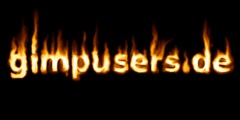to much shine!!!
This discussion is connected to the gimp-user-list.gnome.org mailing list which is provided by the GIMP developers and not related to gimpusers.com.
This is a read-only list on gimpusers.com so this discussion thread is read-only, too.
| to much shine!!! | scott092707@aol.com | 08 Nov 22:09 |
| to much shine!!! | Ofnuts | 09 Nov 09:29 |
to much shine!!!
Re: what "Steve Kinney admin@pilobilus.net" said:
"In some instances it is possible to take multiple photos at different exposures, and combine them so that the over- and underexposed parts are discarded, leaving one natural looking image. "
This technique is exposure-blending or tone-blending (not sure of the exact term, or the difference between the two named terms).
In the future, if your camera has "exposure bracketing", I would use it. What this does is take (usually 3) exposures, one at what it thinks is the correct exposure, one with less exposure, and one with more exposure., Normally, one can tell the camera how much less/more to go, within certain limits - Mine, for example will go up to one "stop" below/above the "correct" exposure.
This is good for (at least) 2 reasons:
For one thing, your camera might not get the exposure right, and one of the other two might
be just what you want.
Secondly, with three exposures, one can do the exposure-blending (?) method that I described
in answer to another question recently:
https://mail.gnome.org/archives/gimp-user-list/2016-November/msg00000.html
Basically, you would bring the three photos into GIMP with Open As Layers, and using layer masks, have the darker areas of the brighter photo, and the brighter areas of the darker photo replace their counterparts in the "correctly exposed" photo.
One can then use Colors->Levels or Colors->Curves on the layer masks to modify how much each photo will influence the final result.
I, also (like Steve), recommend a tripod, but on a bright day, each photo's exposure will be so short,
that the camera or other moving objects will not have moved enough to ruin things.
Note: even with a tripod, you will need to align the layers, as they will probably be at least a few
pixels off. (even with a tripod, I have occasionally had to actually rotate an image a small amount
to get things to line up!)
Remember when you are "done", to use Rectangle Select on the final image and Canvas To Selection,
or you will have thin strips of overhanging layers at the edges of the image, where layers were moved
away from each other a few pixels when aligning.
Alignment is key. If the layers don't quite line up, the final result will be fuzzy. Like most jobs, preparing to do a job is most of the time used. Many a time, In editing a photo, Colors ->Levels->Auto gave a great result - a couple of seconds right? Sure!, but only after laboriously selecting areas that were way too bright (or dark. or both...) and inverting the selection, so that Levels did not "see" those areas. Or first making a new layer with a white/black gradient, and fiddling with the opacity to level out the exposure.
-Scott
P.S. Sorry to go on so long - I often find it hard to find the off switch...!
to much shine!!!
This is fine for landscape photography (even if using the camera in "raw" mode makes that somewhat less useful than it used to be), but here we are talking about taking picture of moving subjects....
On 08/11/16 23:09, scott092707@aol.com wrote:
Re: what "Steve Kinney admin@pilobilus.net" said:
"In some instances it is possible to take multiple photos at different exposures, and combine them so that the over- and underexposed parts are discarded, leaving one natural looking image. "
This technique is exposure-blending or tone-blending (not sure of the exact term, or the difference between the two named terms).
In the future, if your camera has "exposure bracketing", I would use it. What this does is take (usually 3) exposures, one at what it thinks is the correct exposure, one with less exposure, and one with more exposure., Normally, one can tell the camera how much less/more to go, within certain limits - Mine, for example will go up to one "stop" below/above the "correct" exposure.
This is good for (at least) 2 reasons: For one thing, your camera might not get the exposure right, and one of the other two might be just what you want.
Secondly, with three exposures, one can do the exposure-blending (?) method that I described in answer to another question recently: https://mail.gnome.org/archives/gimp-user-list/2016-November/msg00000.htmlBasically, you would bring the three photos into GIMP with Open As Layers, and using layer masks, have the darker areas of the brighter photo, and the brighter areas of the darker photo replace their counterparts in the "correctly exposed" photo.
One can then use Colors->Levels or Colors->Curves on the layer masks to modify how much each photo will influence the final result.











